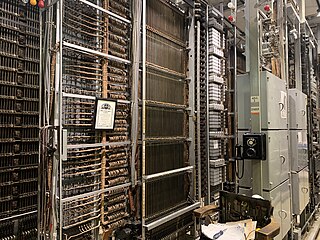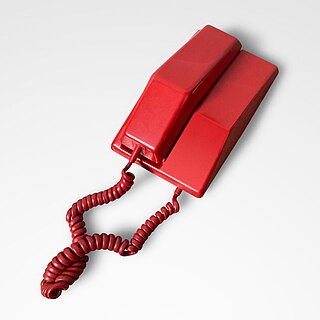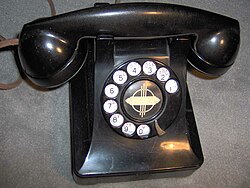
A telephone is a telecommunications device that permits two or more users to conduct a conversation when they are too far apart to be easily heard directly. A telephone converts sound, typically and most efficiently the human voice, into electronic signals that are transmitted via cables and other communication channels to another telephone which reproduces the sound to the receiving user. The term is derived from Greek: τῆλε and φωνή, together meaning distant voice. A common short form of the term is phone, which came into use early in the telephone's history. Nowadays, phones are almost always in the form of smartphones or mobile phones, due to technological convergence.
The Western Electric Company was an American electrical engineering and manufacturing company officially founded in 1869. A subsidiary of the American Telephone and Telegraph Company for most of its lifespan, it served as the primary equipment manufacturer, supplier, and purchasing agent for the Bell System from 1881 until 1984, when the system was dismantled. The company was responsible for many technological innovations, as well as developments in industrial management.

The Trimline telephone is a series of telephones that was produced by Western Electric, the manufacturing unit of the Bell System. These telephones were first introduced in 1965 and are formally referred to as the No. 220 Hand Telephone Sets. The Trimline was designed by Henry Dreyfuss Associates under the project direction of Donald Genaro; the firm had produced the previous post-war desktop telephone types for the American Telephone & Telegraph Company.

A telephone call or telephone conversation, also known as a phone call or voice call, is a connection over a telephone network between the called party and the calling party. Telephone calls started in the late 19th century. As technology has improved, a majority of telephone calls are made over a cellular network through mobile phones or over the internet with Voice over IP. Telephone calls are typically used for real-time conversation between two or more parties, especially when the parties cannot meet in person.

The Ericofon is a one-piece plastic telephone created by the Ericsson Company of Sweden and marketed through the second half of the 20th century. It was the first commercially marketed telephone to incorporate the dial and handset into a single unit. Because of its styling and its influence on future telephone design, the Ericofon is considered one of the most significant industrial designs of the 20th century by Phaidon. It is in the collection of the Museum of Modern Art in New York City. In Sweden, the Ericofon is known as the cobra telephone for its resemblance to a coiled snake.

A telephone jack and a telephone plug are electrical connectors for connecting a telephone set or other telecommunications apparatus to the telephone wiring inside a building, establishing a connection to a telephone network. The plug is inserted into its counterpart, the jack, which is commonly affixed to a wall or baseboard. The standards for telephone jacks and plugs vary from country to country, though the 6P2C style modular plug has become by far the most common type.

The Western Electric model 500 telephone series was the standard domestic desk telephone set issued by the Bell System in[North America from 1950 through the 1984 Bell System divestiture. The successor to the model 302 telephone, the model 500's modular construction compared to previous types simplified manufacture and repair and facilitated a large number of variants with added features. Touch-tone service was introduced to residential customers in 1963 with the model 1500 telephone, which had a push-button pad for the ten digits. The model 2500 telephone, introduced in 1968, added the * (asterisk) and # (pound) keys.

Design Line, also known as Deco-Tel, is a brand name that AT&T has used for several of its specialty telephone designs to fulfill the demand by customers for more variety in telephone models.

The Princess telephone was introduced by the Bell System in 1959. It was a compact telephone designed for convenient use in the bedroom, and contained a light-up dial for use as a night-light. It was commonly advertised with the slogan "It's little...It's lovely...It lights", which was suggested by Robert Karl Lethin, an AT&T employee.

Ericsson Dialog is a Swedish telephone model by Ericsson, released 1964. Millions of the model were sold and it retained its place in homes well into the 1990s. The Ericsson company presented King Carl XVI Gustaf of Sweden with a unique handmade Dialog telephone on his 40th birthday.

The 1A2 Key Telephone System is a business telephone system developed and distributed by the Western Electric Company for the Bell System.

The model 5302 telephone was a look-alike product to the 500-type telephone that was introduced as a stopgap by Western Electric in 1955 to meet the increasing post-World War II demand for a modernized telephone. It reused existing component supplies from the older model 302 that the model 502 replaced. The 302 had been issued since 1937, but starting in 1950, units were replaced with the new 500-series sets, without having served their useful component life.
The General Post Office (GPO) of the United Kingdom carried the sole responsibility for providing telecommunication services across the country with the exception of Hull. The GPO issued a range of telephone instruments to telephone service subscribers that were matched in function and performance to its telephone exchanges.

The candlestick telephone is a style of telephone that was common from the late 1890s to the 1940s. A candlestick telephone is also often referred to as a desk stand, an upright, or a stick phone. Candlestick telephones featured a mouthpiece (transmitter) mounted at the top of the stand, and a receiver (earphone) that was held by the user to the ear during a call. When the telephone was not in use, the receiver rested in the fork of the switch hook protruding to the side of the stand, thereby disconnecting the audio circuit from the telephone network.

A ringer box is a telephone signaling device, similar to a bell box. It usually contains an electromechanical gong and was used with most early desk stand telephones, such as candlestick telephones and the Western Electric type Western Electric hand telephone sets, which were too small to hold a ringer and other required electrical components. Many pay station telephones also used a separate ringer box.

A telephone exchange, also known as a telephone switch or central office, is a crucial component in the public switched telephone network (PSTN) or large enterprise telecommunications systems. It facilitates the interconnection of telephone subscriber lines or digital system virtual circuits, enabling telephone calls between subscribers.

The Bakelite phone (bakelittelefon) officially known as Ericsson DBH 1001, and later as M33, N1020, and ED 702, was a Swedish line of telephones made from the polymer Bakelite and produced for over thirty years between 1931 and 1962.

The Panel Machine Switching System is a type of automatic telephone exchange for urban service that was used in the Bell System in the United States for seven decades. The first semi-mechanical types of this design were installed in 1915 in Newark, New Jersey, and the last were retired in the same city in 1983.

The Contempra is a telephone designed and produced by Northern Electric beginning in 1967. Contempra was the first phone designed in Canada, previous Canadian sets having been designed in the US for Western Electric and built under licence.

The Western Electric hand telephone sets comprise a series of telephones that were produced from 1927 by the Western Electric Company for the American Telephone and Telegraph Company (AT&T) and the Bell System. The series features the mouthpiece (transmitter) and the earpiece (receiver) combined into a hand-held unit, originally named a hand telephone, or handset. The handset would be held against the ear and in front of the mouth simultaneously, in contrast to earlier telephones in the Bell System where only the receiver was held against the ear, while the user spoke into a fixed transmitter mounted on a telephone stand or wall telephone.




















